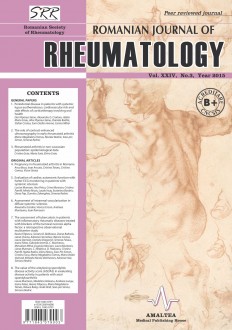SELECT ISSUE

Indexed

| |

|
|
|
| |
|
|
|

|
|
|
|
|
|
| |
|
|
HIGHLIGHTS
National Awards “Science and Research”
NEW! RJR has announced the annually National Award for "Science and Research" for the best scientific articles published throughout the year in the official journal.
Read the Recommendations for the Conduct, Reporting, Editing, and Publication of Scholarly work in Medical Journals.
The published medical research literature is a global public good. Medical journal editors have a social responsibility to promote global health by publishing, whenever possible, research that furthers health worldwide.
THE VALUE OF THE ANKYLOSING SPONDYLITIS DISEASE ACTIVITY SCORE (ASDAS) IN EVALUATING DISEASE ACTIVITY IN PATIENTS WITH AXIAL SPONDYLOARTHRITIS
Laura Muntean, Madalina Valeanu, Andreea Lungu, Ioana Felea, Ileana Filipescu, Maria Magdalena Tamas, Raluca Balaj, Linda Ghib, Simon Siao-Pin and Simona Rednic
ABSTRACT
Aim. To evaluate the clinical value of the Ankylosing Spondylitis Disease Activity Score (ASDAS) in assessing disease activity in axial SpA patients in comparison with conventional clinical measures of disease activity in daily clinical practice.
Patients and methods. Eighty-five patients with axial SpA were included in a cross-sectional study. Disease activity was assessed by Bath Ankylosing Spondylitis Disease Activity (BASDAI) score, ASDAS score with C-reactive protein (ASDAS-CRP), ASDAS score with erythrocyte sedimentation rate (ASDAS-ESR), patient’s global assessment of disease activity (PtGA), CRP and ESR, while physical function was evaluated by the Bath Ankylosing Spondylitis Functional Index (BASFI). The correlation between different markers of disease activity and functional capacity and ASDAS scores were determined. Patients were grouped into high and low disease activity states according to PtGA scores, CRP levels and BASDAI scores. We compared the discriminating ability of the two ASDAS versions and the conventional clinical measures of disease activity in differentiating between patients with high and low disease activity by using standardized mean differences and receiver operating characteristic (ROC) curve analysis.
Results. ASDAS-CRP and ASDAS-ESR showed good correlation with BASDAI (r = 0.84 and 0.72, respectively), PtGA (r = 0.82 and 0.74, respectively), and BASFI (r = 0.74 and 0.70, respectively). Moderate correlations were seen between the two ASDAS versions and ESR and CRP (r ranged from 0.43 to 0.70). The ASDAS versions had higher discriminating capacities as compared to conventional patient-reported measures (BASDAI and PtGA) and objective markers of disease activity (CRP and ESR). The ASDAS-CRP performed better than ASDAS-ESR. Both ASDAS versions and BASDAI had high areas under the curve (AUC) according to PtGA and CRP levels (AUC ranged from 0.66 to 0.92, all p < 0.01). The calculated cut-offs for discriminating between disease activity states in our axSpA patients were relatively similar to the Assessment of Spondyloarthritis International Society (ASAS) endorsed cut-offs.
Conclusions. ASDAS versions had higher discriminating ability in patients with axSpA in terms of high and low disease activity states than conventional measures. These findings suggest that ASDAS is a valid and reliable assessment tool for axial SpA patients in daily clinical practice.
Keywords: axial spondyloarthritis, ASDAS, BASDAI, patient global assessment, disease activity
